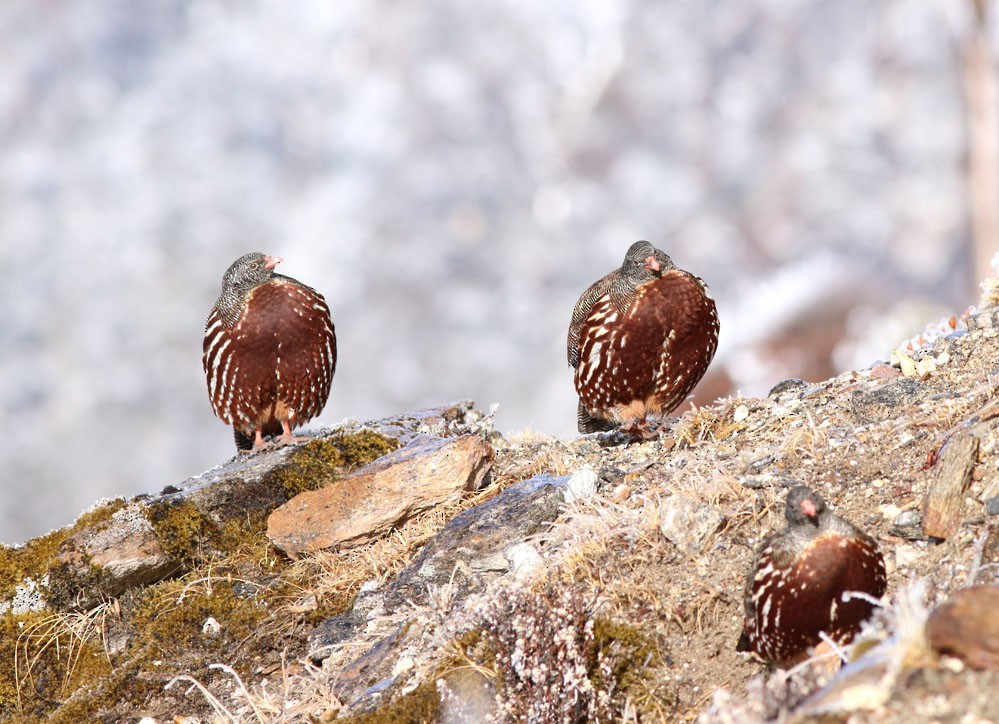Snow Partridge
A species of Snow Partridge Scientific name : Lerwa lerwa Genus : Snow Partridge
Snow Partridge, A species of Snow Partridge
Botanical name: Lerwa lerwa
Genus: Snow Partridge
Content
Description General Info
 Photo By Rofikul Islam
Photo By Rofikul Islam Description
This partridge appears grey above and chestnut below with bright red bill and legs and the upperparts finely barred in black and white. In flight the pattern of dark brown primaries and secondaries with a narrow trailing white margin make them somewhat like the much larger Tibetan snowcock. The 14-feathered tail is dark and barred in white. There is variation in the shade and some birds have a nearly black crown. The primaries and secondaries are brown and the breast is deep chestnut. The abdomen has more white and the lower flanks and feathers around the vent are barred brown and white. The under-tail coverts are chestnut with black shaft streaks and white tips. Young birds have the lower parts mottled and the barring less distinct. The tarsus is feathered on the front of the leg half-way to the toes. It measures 38–40 cm in length. Females weigh 450–580 g; males, 550–700 g. Sexes are similar in plumage, female lacks spurs on the tarsus while the male has a blunt spur and sometimes a second incipient spur. Downy chicks have a resemblance to the chicks of the blood pheasant. Chicks are born with the tarsi feathered and the nostril opening is covered by feathers. 
Size
40 cm
Nest Placement
Ground
Feeding Habits
Snow Partridge primarily consumes plant matter, including lichens, moss, seeds, flowers, leaves, and shoots, with a preference for Agrostis, Festuca, and Polygonum grass species. Snow Partridge also ingests herbs like gentians and Potentilla and a minimal amount of animal food. They forage in pairs or groups, occasionally forming larger roosts.
Habitat
The snow Partridge primarily inhabits alpine meadows and rugged, rocky hillsides that are above the treeline. Its preferred environment includes regions with a mix of rhododendron bushes, grasses, ferns, and lichens, and it gravitates toward areas with lower snow presence in winter and higher precipitation levels in summer. Its presence across broader geographical regions spans habitats from sparse grass and herb cover with exposed rock to dense meadows and shrubby grassland interspersed with willow species, as well as high-altitude coniferous forests.
Dite type
Herbivorous
General Info
Feeding Habits
Bird food type
Behavior
The snow partridge is found is small groups, usually about 6 to 8 but up to 30 during the non-breeding season. When flushed, they usually fly up before scattering away with noisy wing beats. The flight is rapid and stirring. It has a habit of sunning itself on rocks during the midday. The call in the breeding season is said to resemble that of the grey francolin of the plains. It has been compared in habit to that of the ptarmigan. It is said to feed on mosses, lichens, berries, and the shoots of plants. It also swallows grit to aid digestion. The breeding season is May to July. The males are believed to be monogynous. The nest is a scrape on a hill-side under some sheltering rock, either scratched out by themselves or already available, and usually hidden with vegetation. The nest is sometimes lined with moss but well concealed although given away by the male. About 3 to 5 eggs, pale yellow in color and slightly glossy with reddish-brown markings on the rounded end, are laid, and the female incubates while the male stands sentinel. Parent birds may use distraction displays to draw the attention of predators. They call in a comparatively softer lower note to the young, which respond with chicken-like cheep calls. Apart from Chelopistes lervicola described as an ectoparasite of this species, an Argasid tick Argas himalayensis has been noted. 
Distribution Area
Snow partridge is found in the Himalayas from Pakistan to Arunachal Pradesh along the higher ranges, mainly 3000 to 5000 m (rarely below 2000 m) altitude. It is found above the tree line but not on as bare and stony terrain as the snowcocks. Although said to be found in Afghanistan, there is no evidence. The species is found over a large area is generally considered to be of low conservation concern. It is hunted to some extent, due to its habit of being more approachable than snowcock and has declined in population in some areas. The usual habitat is alpine pastures, open grassy hillsides with grass, lichens, moss, ferns and rhododendrons. Is found among small snow-patches but not in as stony or bare ground as the snowcock. The birds however are very local in their distribution. 

 Photo By Rofikul Islam
Photo By Rofikul Islam